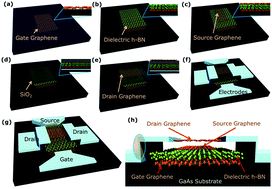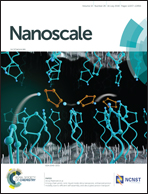Fabrication of a three-terminal graphene nanoelectromechanical switch using two-dimensional materials†
Abstract
An alternative three-terminal (3T) subthermal subthreshold slope (SS) switch is required to overcome the exponential increase in leakage current with an increase in the drive current of CMOS devices. In this study, we present a 3T graphene nanoelectromechanical (3T-GNEM) switch with a physically isolated channel in the off-state by using heterogeneously stacked two-dimensional (2D) materials. Hexagonal boron nitride (h-BN) was used as a dielectric layer, and graphene was used as a the top double-clamped beam drain, gate and source electrode material; the drain, gate, and source layers were stacked vertically to achieve a small footprint. The drain to source contact is normally open with an air gap in the off-state, and the gate voltage is applied to mechanically deflect the drain terminal of the doubly clamped graphene beam to make electric contact with the source terminal for the on-state. This 3T-GNEM switch exhibits an SS as small as 10.4 mV dec−1 at room temperature, a pull-in voltage less than 6 V, and a switching voltage window of under 2 V. Since the source and drain terminals are not connected physically in the off-state, this 3T-GNEM switch is a promising candidate for future high-performance low-power logic circuits and all-2D flexible electronics.



 Please wait while we load your content...
Please wait while we load your content...